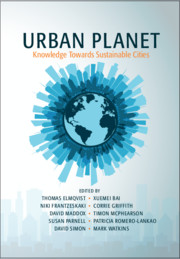Artists are underutilized assets for cities and the environment: People often perceive climate change and other environmental risks as future events, happening to people in places far away, outside their own experience. Art has the power to involve people through visceral and place-based experiences, direct personal connection, and emotional engagement to evoke reaction and inspire action.
City as Living Laboratory (CALL) proposes that sustainability can be made tangible and accessible to communities through the arts. We have been developing our methodology since 2009 with the intention of articulating a replicable framework that can be used in other cities. CALL’s framework consists of research, dialogues, and projects that intend to harness a sense of wonder and optimism to make people curious about their surroundings.
Results require long-term engagements and interdisciplinary teams: In Indianapolis in late September 2015, a community-wide project focusing on the tributaries of the White River was launched through with the support of a National Science Foundation grant. This grew out of FLOW, a project I completed in 2011 that drew attention to a six-mile stretch of the White River. That FLOW initiative was catalytic; it lead to the formation of a community organization, Reconnecting to Our Waterways, or ROW, that partnered on the grant, along with Butler University and the New Knowledge Organization. For this citywide project, I developed the conceptual framework and visual components of STREAM / LINES to highlight these five tributaries of the White River through contextual, immersive, and game-like experiences of the selected sites and their unique characteristics. It was a collaborative project involving a game designer, scientists, poets, musicians, and dancers.
Engagement benefits from multiple access points: In five modest neighbourhoods, a cluster of mirrors and red beams radiate out from a central point to nearby streams and waterways: these elements stake out a territory for observation. At the center, visitors can step up onto a pedestal to see their own image in a four-foot diameter mirror that places them in the middle of the reflected landscape while casting them in the role of the statue/activator/principal character. Single words and texts are reflected in the smaller mirrors that dot the site; some of the texts are poems, while others are prompts that encourage exploration. All are intended to provoke the visitor’s curiosity and send them out to the nearby waterways.
Engaging all of the senses is key: Whether following a red beam out to observe habitat at a stream’s edge, trying to walk at the same pace as the flow of the stream, or listening to music composed for each unique location, the goal is to engage citizens with a place-based experience of the waterways that supports every aspect of their lives. The installations are like anchors, the starting points for explorations, and will be activated over time by walks and dialogues with scientists and artists, by performances and readings. Engagement of the sites through programming is essential. The goal is to allow the people of Indianapolis to begin to imagine what they would like to see their streams, lakes, and rivers become in the future.
Diverse perspectives and community input are essential: The projects and contingent programming are part of a process of engagement that depends on the collaborative efforts of communities, various experts, and artists. Finding willing and enthusiastic participants is key. We look for people with very different ways of regarding the landscape, who can reveal their own observations to others: a climatologist points out the link between traffic patterns and ways to enjoy good weekend weather, while a poet reflects on the change over time of a particular place, or an ecologist reveals more about a day in the life of a turtle, or a community member describes the stream she knew before it was put in a pipe. Each of these “experts” can add a layer of insight into our surroundings. We are given a more complete picture of our landscape and our place in it.
Systemic challenges like global warming must be linked to the everyday: CALL proposes that rather than assuming only a top-down, governmental approach, we engage communities and citizens on the street with the pressing issues of our times. Rather than only focusing on a negative forecast of the future, the goal is to bring people together and to provide a platform to explore innovative, positive ways forward in creating socially and environmentally sustainable communities.
To promote/facilitate replication and scaling up, CALL focuses on specific principles and strategies: The City as Living Laboratory is building a methodology to engage artists with a process to be able to work with other experts, communities, and policy-makers to make lives of sustenance available to all.The replicable framework we are developing focuses on:
Encouraging inquiry and exploration
Envisioning future possibilities
Promoting interdisciplinary and dynamic thinking
Encouraging and promoting innovation and practical solutions
Bringing diverse cultural perspectives to the projects
Harnessing interdisciplinary collaborations led by artists
Producing distinctive artistic contributions
It is important that artists be recognized as essential members of the team addressing social and environmental issues in our cities and communities. We can have value beyond supplying artwork for the 1 percent of the population who are able to participate in the art market. Artists in the broadest sense – poets, musicians, dancers, and performers of all types – are an essential resource that must be recognized for the significance of the contribution they can make to help create an equitable and sustainable society.



